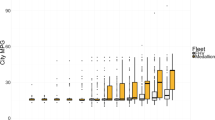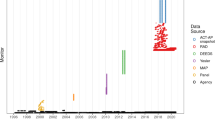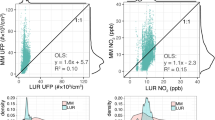Abstract
Spatial modeling of traffic-related air pollution typically involves either regression modeling of land-use and traffic data or dispersion modeling of emissions data, but little is known to what extent land-use regression models might be improved by incorporating emissions data. The aim of this study was to develop a land-use regression model to predict nitrogen dioxide (NO2) concentrations and compare its performance with a model including emissions data. The association between each land-use variable and NO2 concentrations at 68 locations in Rome in 1995 and 1996 was assessed by univariate linear regression and a multiple linear regression model that was constructed based on the importance of each variable. Traffic emissions (particulate matter, carbon monoxide, nitrogen oxides, and benzene) were estimated for 164 areas of the city based on vehicle type, traffic counts and driving patterns. Mean NO2 concentration across the 68 sites was 46.8 μg/m3 (SD 9.8 μg/m3; inter-quartile range 11.5 μg/m3; min 24 μg/m3; max 73 μg/m3). The most important predicting variables were the circular traffic zones (main ring road, green strip, inner ring road, traffic-limited zone), distance from busy streets, size of the census block, the inverse population density, and altitude. A multiple regression model including these variables resulted in an R2 of 0.686. The best-fitting model adding an emission term of benzene resulted in an R2 of 0.690, but was not significantly different from the model without emissions (P=0.147). In conclusion, these results suggest that a land-use regression model explains the traffic-related air pollution levels with reasonable accuracy and that emissions data do not significantly improve the model.
This is a preview of subscription content, access via your institution
Access options
Subscribe to this journal
Receive 6 print issues and online access
$259.00 per year
only $43.17 per issue
Buy this article
- Purchase on Springer Link
- Instant access to full article PDF
Prices may be subject to local taxes which are calculated during checkout




Similar content being viewed by others
References
Abbey D.E., et al. Long-term inhalable particles and other air pollutants related to mortality in nonsmokers. Am J Respir Crit Care Med 1999: 159: 373–382.
Bellander T., et al. Using geographic information systems to assess individual historical exposure to air pollution from traffic and house heating in Stockholm. Environ Health Perspect 2001: 109: 633–639.
Brauer M., et al. Air pollution from traffic and the development of respiratory infections and asthmatic and allergic symptoms in children. Am J Respir Crit Care Med 2002: 166: 1092–1098.
Brauer M., et al. Estimating long-term average particulate air pollution concentrations: application of traffic indicators and geographic information systems. Epidemiology 2003: 14: 228–239.
Briggs D. The role of GIS: coping with space (and time) in air pollution exposure assessment. J Toxicol Environ Health 2005: 68: 1243–1261.
Briggs D.J., et al. A regression-based method for mapping traffic-related air pollution: application and testing in four contrasting urban environments. Sci Total Environ 2000: 253: 151–167.
Briggs D.J. The use of GIS to evaluate traffic-related pollution. Occup Environ Med 2007: 64: 1–2.
Ciccone G., et al. Road traffic and adverse respiratory effects in children. SIDRIA Collaborative Group. Occup Environ Med 1988: 55: 771–778.
Clench-Aas J., Bartonova A., Gronskei K.E., Hagen L.O., Braathen O.A., and Walker S.E. Air pollution exposure monitoring and estimation. Part VI. Ambient exposure of adults in an industrialised region. J Environ Monit 1999: 1: 341–347.
Cyrys J., et al. GIS-based estimation of exposure to particulate matter and NO2 in an urban area: stochastic versus dispersion modeling. Environ Health Perspect 2005: 113: 987–992.
Dockery D.W., et al. An association between air pollution and mortality in six US cities. N Engl J Med 1993: 329: 1753–1759.
English P., Neutra R., Scalf R., Sullivan M., Waller L., and Zhu L. Examining associations between childhood asthma and traffic flow using a geographic information system. Environ Health Perspect 1999: 107: 761–767.
Farchi S., Forastiere F., Cesaroni G., and Perucci C.A. Environmental exposures and hospitalization for respiratory conditions in children: a five-year follow-up study in Rome, Italy. Occup Environ Med 2006: 63: 573–576.
Gauvin S., et al. Relationships between nitrogen dioxide personal exposure and ambient air monitoring measurements among children in three French metropolitan areas: VESTA study. Arch Environ Health 2001: 56: 336–341.
Gehring U., et al. Traffic-related air pollution and respiratory health during the first 2 yrs of life. Eur Respir J 2002: 19: 690–698.
Gilbert N.L., Goldberg M.S., Beckerman B., Brook J.R., and Jerrett M. Assessing spatial variability of ambient nitrogen dioxide in Montreal, Canada, with a land-use regression model. J Air Waste Manag Assoc 2005: 55: 1059–1063.
Hoek G., Brunekreef B., Goldbohm S., Fischer P., and van den Brandt P.A. Association between mortality and indicators of traffic-related air pollution in the Netherlands: a cohort study. Lancet 2002: 360: 1203–1209.
Hoek G., Fischer P., Van Den Brandt P., Goldbohm S., and Brunekreef B. Estimation of long-term average exposure to outdoor air pollution for a cohort study on mortality. J Expo Anal Environ Epidemiol 2001: 11: 459–469.
Jerrett M., et al. A review and evaluation of intraurban air pollution exposure models. J Expo Anal Environ Epidemiol 2005a: 15: 185–204.
Jerrett M., et al. Spatial analysis of air pollution and mortality in Los Angeles. Epidemiology 2005b: 16: 727–736.
Kramer U., Koch T., Ranft U., Ring J., and Behrendt H. Traffic-related air pollution is associated with atopy in children living in urban areas. Epidemiology 2000: 11: 64–70.
Langholz B., Ebi K.L., Thomas D.C., Peters J.M., and London S.J. Traffic density and the risk of childhood leukemia in a Los Angeles case-control study. Ann Epidemiol 2002: 12: 482–487.
Liu L.J., Delfino R., and Koutrakis P. Ozone exposure assessment in a southern California community. Environ Health Perspect 1997: 105: 58–65.
Maheswaran R., and Elliott P. Stroke mortality associated with living near main roads in England and wales: a geographical study. Stroke 2003: 34: 2776–2780.
Mukala K., Alm S., Tiittanen P., Salonen R.O., Jantunen M., and Pekkanen J. Nitrogen dioxide exposure assessment and cough among preschool children. Arch Environ Health 2000: 55: 431–438.
Nafstad P., et al. Urban air pollution and mortality in a cohort of Norwegian men. Environ Health Perspect 2004: 112: 610–615.
Nyberg F., et al. Urban air pollution and lung cancer in Stockholm. Epidemiology 2000: 11: 487–495.
Pope C.A., et al. Particulate air pollution as a predictor of mortality in a prospective study of U.S. adults. Am J Respir Crit Care Med 1995: 151: 669–674.
Rosenlund M., Berglind N., Pershagen G., Hallqvist J., Jonson T., and Bellander T. Long-term exposure to urban air pollution and myocardial infarction. Epidemiology 2006: 17: 383–390.
Ross Z., English P.B., Scalf R., Gunier R., Smorodinsky S., Wall S., and Jerrett M. Nitrogen dioxide prediction in Southern California using land use regression modeling: potential for environmental health analyses”. J Expo Sci Environ Epidemiol 2006: 16: 106–114.
SIDRIA Collaborative Group. Asthma and respiratory symptoms in 6–7 yr old Italian children: gender, latitude, urbanization and socioeconomic factors. SIDRIA (Italian studies on respiratory disorders in childhood and the environment). Eur Respir J 1997: 10: 1780–1786.
van Vliet P., Knape M., de Hartog J., Janssen N., Harssema H., and Brunekreef B. Motor vehicle exhaust and chronic respiratory symptoms in children living near freeways. Environ Res 1997: 74: 122–132.
Venn A., et al. Local road traffic activity and the prevalence, severity, and persistence of wheeze in school children: combined cross sectional and longitudinal study. Occup Environ Med 2000: 57: 152–158.
Venn A.J., Lewis S.A., Cooper M., Hubbard R., and Britton J. Living near a main road and the risk of wheezing illness in children. Am J Respir Crit Care Med 2001: 164: 2177–2180.
Wilkinson P., et al. Case-control study of hospital admission with asthma in children aged 5–14 years: relation with road traffic in north west London. Thorax 1999: 54: 1070–1074.
Wyler C., et al. Exposure to motor vehicle traffic and allergic sensitization. The Swiss study on air pollution and lung diseases in adults (SAPALDIA) team. Epidemiology 2000: 11: 450–456.
Zachariadis T., and Samaras Z. An integrated modeling system for the estimation of motor vehicle emissions. J Air Waste Manage Assoc 1999: 49: 1010–1026.
Zmirou D., et al. Five epidemiological studies on transport and asthma: objectives, design and descriptive results. J Expo Anal Environ Epidemiol 2002: 12: 186–196.
Acknowledgements
We thank Eriberto De Munari (Emilia-Romagna Environmental Protecion Agency) for the NO2 measurements with the passive dosimeters and Eugenio Donato (Rome City Council) and Anna Atzori (Mobility Agency of Rome -STA) for providing traffic emissions data.
Author information
Authors and Affiliations
Corresponding author
Rights and permissions
About this article
Cite this article
Rosenlund, M., Forastiere, F., Stafoggia, M. et al. Comparison of regression models with land-use and emissions data to predict the spatial distribution of traffic-related air pollution in Rome. J Expo Sci Environ Epidemiol 18, 192–199 (2008). https://doi.org/10.1038/sj.jes.7500571
Received:
Accepted:
Published:
Issue Date:
DOI: https://doi.org/10.1038/sj.jes.7500571
Keywords
This article is cited by
-
Glomerular function in relation to fine airborne particulate matter in a representative population sample
Scientific Reports (2021)
-
Road Traffic and Urban Form Factors Correlated with the Incidence of Lung Cancer in High-density Areas: An Ecological Study in Downtown Shanghai, China
Journal of Urban Health (2021)
-
School environment associates with lung function and autonomic nervous system activity in children: a cross-sectional study
Scientific Reports (2019)
-
Nitrogen dioxide levels estimated from land use regression models several years apart and association with mortality in a large cohort study
Environmental Health (2012)
-
Understanding Road Usage Patterns in Urban Areas
Scientific Reports (2012)



